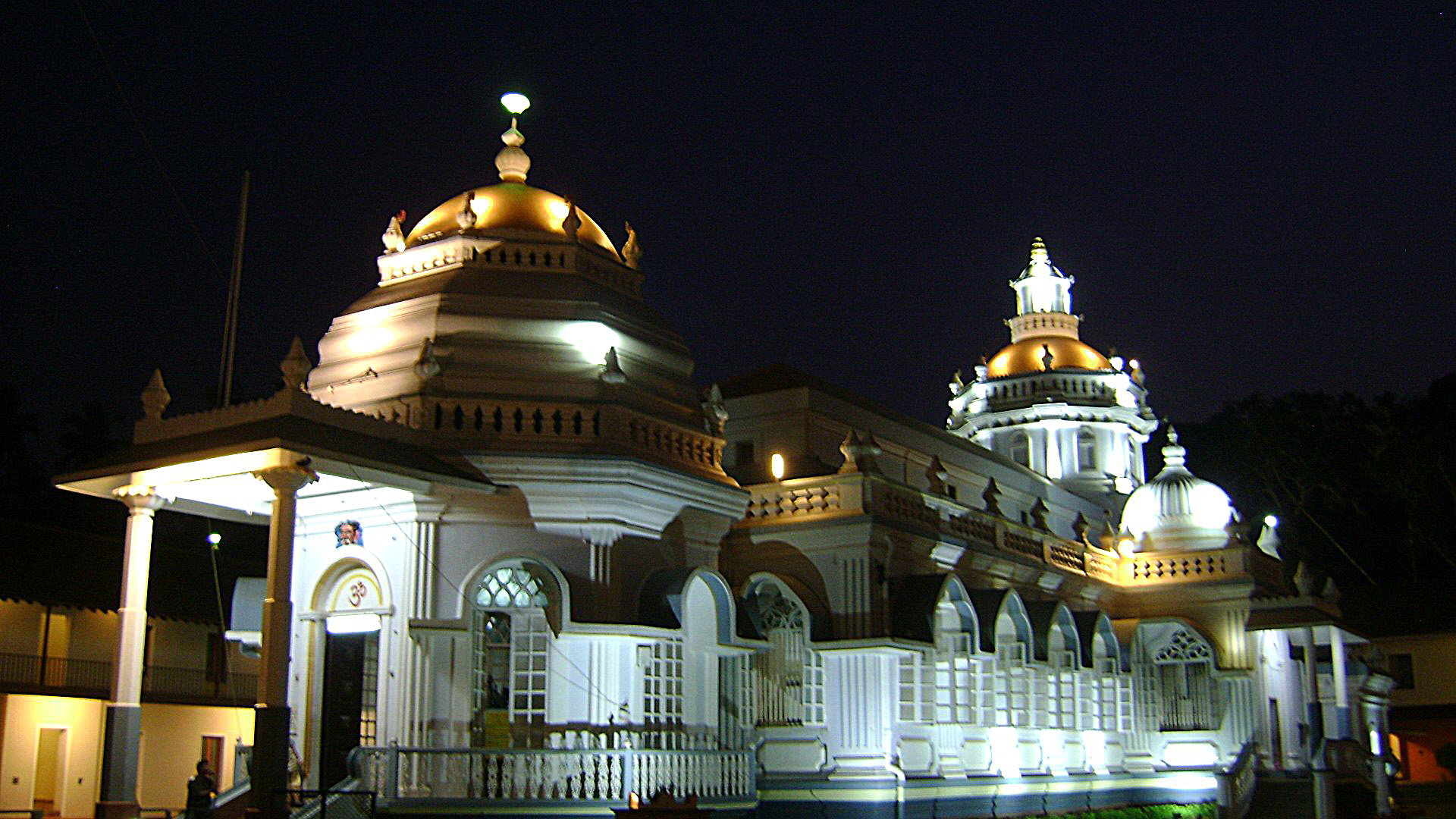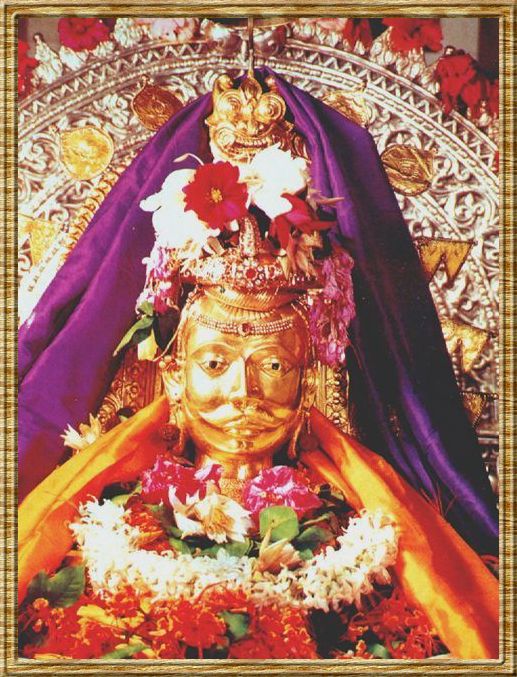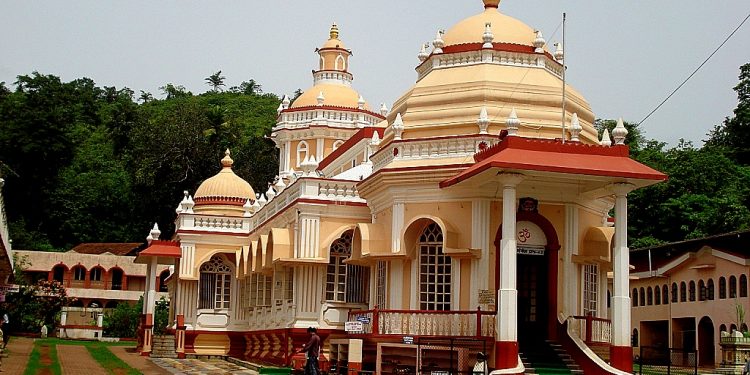Shri Mangesh temple is one of the largest and most frequently visited temples in Goa.Main deity here is Shiva and the temple is in pure Goan Style
Shrine’s History
he temples origins come from Kushasthali and which is now known as Cortalim, a village in Salcette. During that time Salcete fell in the hands of the Portuguese rule in 1543. And this temple was dutifully preserved until the arrival of the inquisition from Europe in 1567. So during the year 1560, the Portuguese started Christian conversions in Salcete taluka, so the Saraswats of Vatsa Gotra felt insecure and shifted the Mangesh Linga from the original site at the Kushasthali on the banks of river Aghanashini to present place in May 1st, 1560 A.D. to the locality now known as Mangeshim in Priol village of Atrunja Taluka, which at that time was ruled by the Hindu kings of Sonde. After remaining in the house of a temple priest for sometime, Shri Mangesh deity was finally installed in its present site at Priol.
The original site was a very simple structure, and the current structure was only built under Maratha rule, so 150 years after it had been moved, the Peshwas donated the village of Mangeshi to the temple in 1739 on the suggestion of their Sardar, Shri Ramchandra Malhar Sukhtankar, who was a staunt follower of Shri Mangesh. Ironically, just a few years after it was built, this area too fell into Portuguese hand in 1764, but by now, the Portuguese had lost their initial religious zeal and had become quite tolerant of other religions, and so, this structure remained untouched.

Legends Associated with This Shrine
The Mangesh Linga is said to have been consecrated on the mountain of Mangireesh (Mongir) on the banks of river Bhagirathi by Lord Brahma himself, from where the Saraswat Brahmins brought it to Trihotrapuri in Bihar. They carried the linga on to Gomantaka and settled at Mathagrama, the present day Madgaon, establishing their most sacred and ancient temple of Mangesh on the banks of the river Gomati or Zuari as it is called today. Lord Mangesh is worshipped here in the shape of a Shiva Linga. Legend has it that once Shiva and Parvati were playing dice in their abode at Mount Kailas. Shiva kept losing, and in the last roll of the dice staked his heaven. Having lost that too, he had to leave the Himalayas. He wandered southwards and presently crossed the Sahyadri mountains and came to Kushasthali, now Cortalim, where Lopesh, his faithful devotee, entreated him to remain. Forlorn Parvati, now heartbroken without Shiva, left heaven and went in search of him. In the midst of a dense forest, she came face to face with a huge tiger. Shiva had taught her an incantation, He Girisha mamtrahi? ? O Lord of the Mountains protect me ? but she was so frightened that she lost her coherence and uttered the jumbled incantation, Trahi mam Girisha?. Shiva, who had assumed the form of a tiger, instantly returned to his normal form. And then at a much relieved Parvatis behest, he added Mam-Girisha to the many appellations he is known by. Which is also how the village where the temple is situated came to be eventually known as Mangeshi, an abbreviation of Mam-Girisha.

Architectural Relevance of This Shrine
In the temple of Mangesh is a prominent Nandi Bull which is considered to be the Vahana (Vehicle) of Shiva. The temple complex consists of a spacious courtyard surrounded by the temple itself and rooms for weddings and pilgrims. The temple also has a magnificent water tank, which is believed to be the oldest part of the temple. The Sabha Griha is a spacious hall which accommodates over 500. The décor includes the chandeliers of the nineteenth century. There are photos of Lord Shiva in different styles.
The devotees are said to assemble here twice a day to meditate and seek peace, solace and the blessings of the Lord. This room also facilitates instrumental equipments to listen to Hari Katha and Kirthana after which the devotees have their first glimpse at the Lord. The central part of the Sabha Griha leads to the Garbha Griha which is kept clear at all times. This allows the devotee to have the darshan of the Lord even from the entrance. The image of Mangesh resides in the garbhgriha of the beautiful temple. It has shrines of Parvati (consort of Shiva ? Destroyer of the Universe) and Ganesha (the elephant-god of Prosperity and Wisdom). Most of the Goan temples are noted for their chiselled architecture and their distinctive style. A beautiful seven-storey deepstambha (lamp tower), typical of Goan temple architecture, stands at the gates in the temple complex., set against a sylvan backdrop of woodlands and rolling green hills that is both pleasing to the eye and satisfying to the soul.
Shrine’s Map Location and How to Go There
By Road
t is located on a Hillock at Proil which is in the Ponda Taluka, surrounded with lush greenery which creates a separate place in the hearts of the onlookers. It is 22 kms from Panjim and 26 kms from Margao. It is one of the largest
By Rail
Goa is connected by trains to all big cities in India
By Air
Goa has an International airport
Events Celebrated at This Shrine
The Shiva Linga is worshipped thrice a day i.e in the morning, afternoon and evening. Shodshopchar pujas, namely Abhishek, Laghurudra and Maharudra are performed every day in the morning followed by Maha-Aarti at noon. Panchopchar pooja followed by Aarti is performed every day at night. Monday is the weekly festival. On this day idol of the Lord is taken out, before the Aarti at night, in a procession in Palakhi (ceremonial chariot) accompanied by music.
The Annual festivals that take place here are Ramanavami, Akshaya Tritiya, Anant Vritotsava, Dussera, and Diwali. The main annual festival of this Temple falls on the day of Magh Pournima? in February (it begins on Magha Shukla Saptami and ends of Magha Poornima). The three-day zatra of Shri Mangesh takes place in the lavish temple in the Ponda district which draws huge and colourful crowds. Navaratri and Shivaratri are observed grandly with Makharotsava. And during the time of March, the festivals of Holi or Shigmo take place here. So readers do view this amazingly beautiful temple.













































